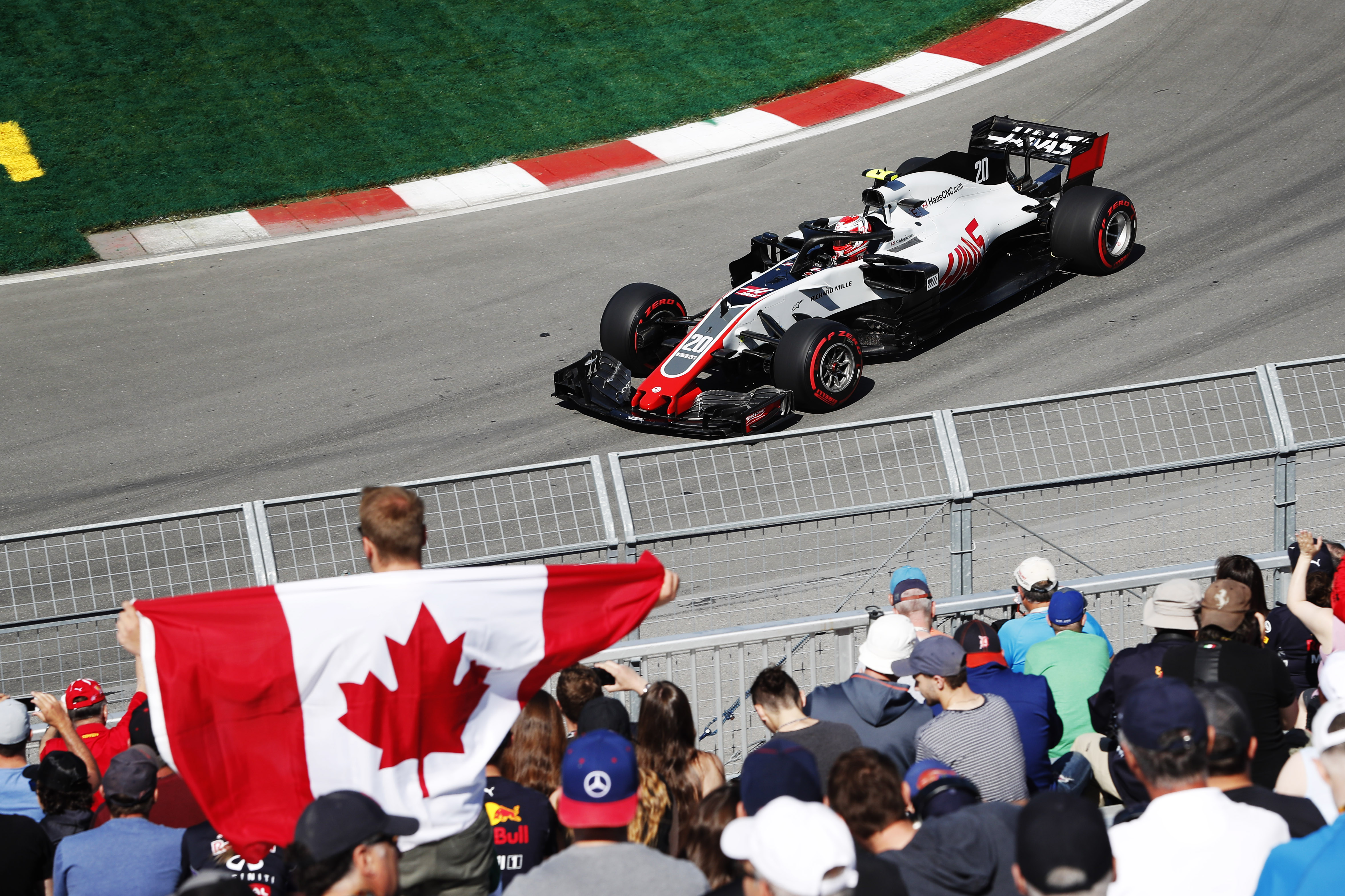
| The seventh round of the 2018 FIA Formula One World Championship began with practice Friday at Circuit Gilles Villeneuve in Montreal as teams prepared for the Canadian Grand Prix Sunday.
Two 90-minute sessions – FP1 and FP2 – on the 4.361-kilometer (2.710-mile), 14-turn layout were run under sunny and comfortable conditions, with Haas F1 Team drivers Romain Grosjean and Kevin Magnussen navigating the evolving conditions of the temporary street circuit on the Île de Notre Dame.
Both drivers performed the same program in FP1, running a total of 21 laps apiece, beginning on the Pirelli P Zero Red supersoft tire before transitioning to the Purple ultrasoft. Grosjean’s quick time of 1:15.119 came on his 17th lap shod on ultrasofts, putting him 12th overall. Magnussen’s best time was a 1:15.579 on his 15th lap, also set on ultrasofts, placing him 15th on the speed chart.
Leading the way in FP1 was Red Bull driver Max Verstappen, whose fast lap of 1:13.302 was .088 of a second better than the next quickest driver, Mercedes’ Lewis Hamilton.
Speeds picked up and lap times dropped in FP2. Grosjean wrapped FP2 as the seventh-quickest driver with a time of 1:13.620, which was 1.499 seconds better than his best lap in FP1. This improvement came despite his session getting cut short in the waning minutes after a run-in with a groundhog damaged the front wing of his Haas VF-18. The groundhog’s time on Earth was subsequently cut short, as well.
Grosjean’s quick time came on the 16th of his 34 laps shod on a set of Pink hypersoft tires – the grippiest and fastest tire in Pirelli’s lineup. Magnussen shaved 1.623 seconds off his FP1 time with a lap of 1:13.956 to climb to 13th overall. His fast lap came on his 19th tour, also while utilizing the hypersoft tire. He completed 39 laps. Grosjean began FP2 on ultrasofts, turning 11 laps before switching to hypersofts. Magnussen started FP2 on supersofts, running nine laps before donning hypersofts.
Verstappen remained atop FP2 with a mark of 1:12.198, which was .130 of a second better than his nearest pursuer, Scuderia Ferrari’s Kimi Räikkönen. The Montreal track record of 1:11.459, set last year by Hamilton in the final round of qualifying, remained intact.
Between the two sessions, Haas F1 Team ran a total of 115 laps – 60 by Magnussen and 55 by Grosjean.
|
| “It’s been a pretty good day. We had FP1 and we learned quite a bit about the new upgrade, then in FP2 the car behaved nicely. We tried all three different (tire) compounds between the two cars – there’s some more work to do, but it’s been encouraging. The new aero package does suit me pretty well. It’s an amazing circuit. I really like the feeling I get here. It’s not easy to find a balance, and the racing line is always changing. The grip is coming up during the weekend, but I really always enjoy driving here. Then at the end, unfortunately, an animal decided to cross the straight line. I did follow the advice – I didn’t steer to avoid it but, unfortunately, we had contact. It was high speed. I couldn’t do anything to avoid it.”
|
| “I had an okay day. I think FP1 was a bit difficult. We didn’t quite understand the tires. It improved a little bit in FP2. We’re still learning, and we still need to analyze more for tomorrow. We’ll find some answers tonight about the tires. The tires are the big subject here in Montreal. I think if we can find some answers with that and get a clear picture of what temperatures we need and how it laps – that’s going to be the most important thing.” |
“There’s still some work to do, but FP2 was definitely a better session than FP1. We’re going in the right direction to understand the upgrade. We were unlucky – Romain hit some kind of animal, which cut short his session and did a lot of damage to the car. Nevertheless, we are working hard for tomorrow, trying to get back where we want to be.” |
| Drivers have one more practice session on Saturday (11:00-12:00 local time) before qualifying starts at 14:00. Qualifying consists of three rounds, with the 15 fastest drivers from Q1 moving on to Q2. Then, the 10 fastest drivers from Q2 advance to Q3 where they’ll battle for the pole. Haas F1 Team PR |





